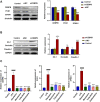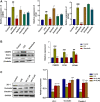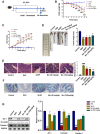Nintedanib Alleviates Experimental Colitis by Inhibiting CEBPB/PCK1 and CEBPB/EFNA1 Pathways
- PMID: 35910380
- PMCID: PMC9331303
- DOI: 10.3389/fphar.2022.904420
Nintedanib Alleviates Experimental Colitis by Inhibiting CEBPB/PCK1 and CEBPB/EFNA1 Pathways
Abstract
The super-enhancer, a cluster of enhancers with strong transcriptional activity, has become one of the most interesting topics in recent years. This study aimed to investigate pathogenic super-enhancer-driven genes in IBD and screen therapeutic drugs based on the results. In this study, through the analysis of differentially expressed genes in colitis patients from the GEO database and the analysis of the super-enhancer-associated database, we found that the super-enhancer pathogenic genes PCK1 and EFNA1 were simultaneously regulated by transcription factor CEBPB through two super-enhancers (sc-CHR20-57528535 and sc-CHR1-155093980). Silencing CEBPB could significantly inhibit the expression of PCK1 and EFNA1 and enhance the expression of epithelial barrier proteins claudin-1, occludin, and ZO-1. In LPS-induced Caco-2 cells, drugs commonly used in clinical colitis including tofacitinib, oxalazine, mesalazine, and sulfasalazine inhibited mRNA levels of CEBPB, PCK1, and EFNA1. In the drug screening, we found that nintedanib significantly inhibited the mRNA and protein levels of CEBPB, PCK1, and EFNA1. In vivo experiments, nintedanib significantly alleviated DSS-induced colitis in mice by inhibiting CEBPB/PCK1 and CEBPB/EFNA1 signaling pathways. At the genus level, nintedanib improved the composition of the gut microbiota in mice with DSS-induced experimental colitis. In conclusion, we found that PCK1 and EFNA1 are highly expressed in colitis and they are regulated by CEBPB through two super-enhancers, and we further demonstrate their role in vivo and in vitro. Nintedanib may be a potential treatment for IBD. Super-enhancers may be a new way to explore the pathogenesis of colitis.
Keywords: CEBPB/EFNA1; CEBPB/PCK1; inflammatory bowel disease; nintedanib; super-enhancer.
Copyright © 2022 Li, Li, Xiao, Hu, Yang, Gu, Jin, Cao, Zhou and Yang.
Conflict of interest statement
The authors declare that the research was conducted in the absence of any commercial or financial relationships that could be construed as a potential conflict of interest.
Figures






Similar articles
-
Short-Chain Fatty Acid Decreases the Expression of CEBPB to Inhibit miR-145-Mediated DUSP6 and Thus Further Suppresses Intestinal Inflammation.Inflammation. 2022 Feb;45(1):372-386. doi: 10.1007/s10753-021-01552-6. Epub 2021 Nov 18. Inflammation. 2022. PMID: 34792688
-
Identification of Potential Pathogenic Super-Enhancers-Driven Genes in Pulmonary Fibrosis.Front Genet. 2021 May 12;12:644143. doi: 10.3389/fgene.2021.644143. eCollection 2021. Front Genet. 2021. PMID: 34054916 Free PMC article.
-
Epigenetic regulation of key gene of PCK1 by enhancer and super-enhancer in the pathogenesis of fatty liver hemorrhagic syndrome.Anim Biosci. 2024 Aug;37(8):1317-1332. doi: 10.5713/ab.23.0423. Epub 2024 Apr 24. Anim Biosci. 2024. PMID: 38665091 Free PMC article.
-
2,3,5,4'-Tetrahydroxystilbene-2-O-β-D-glucoside, a major bioactive component from Polygoni multiflori Radix (Heshouwu) suppresses DSS induced acute colitis in BALb/c mice by modulating gut microbiota.Biomed Pharmacother. 2021 May;137:111420. doi: 10.1016/j.biopha.2021.111420. Epub 2021 Feb 23. Biomed Pharmacother. 2021. PMID: 33761623
-
LncRNA LEF1-AS1 silencing diminishes EZH2 expression to delay hepatocellular carcinoma development by impairing CEBPB-interaction with CDCA7.Cell Cycle. 2020 Apr;19(8):870-883. doi: 10.1080/15384101.2020.1731052. Epub 2020 Mar 16. Cell Cycle. 2020. PMID: 32178558 Free PMC article.
Cited by
-
Transcriptomic Analysis of PDCoV-Infected HIEC-6 Cells and Enrichment Pathways PI3K-Akt and P38 MAPK.Viruses. 2024 Apr 9;16(4):579. doi: 10.3390/v16040579. Viruses. 2024. PMID: 38675921 Free PMC article.
-
Key Disease-Related Genes and Immune Cell Infiltration Landscape in Inflammatory Bowel Disease: A Bioinformatics Investigation.Int J Mol Sci. 2024 Sep 9;25(17):9751. doi: 10.3390/ijms25179751. Int J Mol Sci. 2024. PMID: 39273699 Free PMC article.
-
Fibroblast Heterogeneity in Inflammatory Bowel Disease.Int J Mol Sci. 2024 Dec 3;25(23):13008. doi: 10.3390/ijms252313008. Int J Mol Sci. 2024. PMID: 39684719 Free PMC article. Review.
-
Latent inter-organ mechanism of idiopathic pulmonary fibrosis unveiled by a generative computational approach.Sci Rep. 2023 Dec 11;13(1):21981. doi: 10.1038/s41598-023-49281-0. Sci Rep. 2023. PMID: 38081956 Free PMC article.
-
Yi-Fei-Tong-Bi Decoction Alleviates Bleomycin Induced Pulmonary Fibrosis in Mice.Drug Des Devel Ther. 2025 May 15;19:3983-3995. doi: 10.2147/DDDT.S515368. eCollection 2025. Drug Des Devel Ther. 2025. PMID: 40391179 Free PMC article.
References
LinkOut - more resources
Full Text Sources
Miscellaneous

